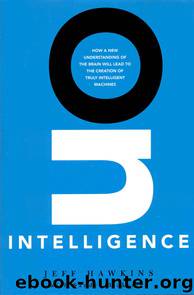On Intelligence by Unknown

Author:Unknown
Language: eng
Format: epub
Published: 0101-01-01T00:00:00+00:00
As information moves up from primary sensory regions to higher levels, we see fewer and fewer changes over time. In primary visual areas like V1, the set of active cells is changing rapidly as new patterns fall on the retina several times each second. In visual area IT, cell firing patterns are more stable. What is happening here? Each region of cortex has a repertoire of sequences it knows, analogous to a repertoire of songs. Regions store these songlike sequences about anything and everything: the sound of surf crashing on the beach, your mother's face, the path from your home to the corner store, how to spell the word "popcorn," how to shuffle a deck of cards.
We have names for songs, and in a similar fashion each cortical region has a name for each sequence it knows. This "name" is a group of cells whose collective firing represents the set of objects in the sequence. (Never mind for now how that group of cells is selected to represent the sequence; we will get to this later.) These cells remain active as long as the sequence is playing, and it is this "name" that is passed up to the next region in the hierarchy. As long as the input patterns are part of a predictable sequence, the region presents a constant "name" to the next higher region.
It's as if the region were saying, "Here is the name of the sequence that I am hearing, seeing, or touching. You don't need to know about the individual notes, edges, or texture. I will let you know if something new or unpredicted happens." More specifically, we can imagine region IT at the top of the visual hierarchy relaying to an association area above it, "I am seeing a face. Yes, with each saccade the eyes are fixating on different parts of the face; I am seeing different parts of the face in succession. But it is still the same face. I will let you know when I see something else." In this fashion, a predictable sequence of events gets identified with a "name" a constant pattern of cell firing. This happens over and over again as we go up the hierarchical pyramid. One region might recognize a sequence of sounds that comprise phonemes (the sounds that make up words) and passes a pattern representing the phoneme up to the next region. The next higher region recognizes sequences of phonemes to create words. The next higher region recognizes sequences of words to create phrases, and so on. Bear in mind that a "sequence" in the lowest regions of cortex may be fairly simple, such as a visual edge moving through space.
By collapsing predictable sequences into "named objects" at each region in our hierarchy, we achieve more and more stability the higher we go. This creates invariant representations.
The opposite effect happens as a pattern moves back down the hierarchy: stable patterns get "unfolded" into sequences. Let's assume you memorized the Gettysburg Address when you were in the seventh grade and now you want to recite it.
Download
This site does not store any files on its server. We only index and link to content provided by other sites. Please contact the content providers to delete copyright contents if any and email us, we'll remove relevant links or contents immediately.
| Africa | Americas |
| Arctic & Antarctica | Asia |
| Australia & Oceania | Europe |
| Middle East | Russia |
| United States | World |
| Ancient Civilizations | Military |
| Historical Study & Educational Resources |
The Radium Girls by Kate Moore(11964)
100 Deadly Skills by Clint Emerson(4872)
Rise and Kill First by Ronen Bergman(4732)
The Templars by Dan Jones(4648)
The Doomsday Machine by Daniel Ellsberg(4442)
The Rape of Nanking by Iris Chang(4162)
Killing England by Bill O'Reilly(3966)
Hitler in Los Angeles by Steven J. Ross(3918)
Stalin by Stephen Kotkin(3908)
12 Strong by Doug Stanton(3524)
Hitler's Monsters by Eric Kurlander(3283)
Blood and Sand by Alex Von Tunzelmann(3159)
The Code Book by Simon Singh(3106)
Darkest Hour by Anthony McCarten(3088)
The Art of War Visualized by Jessica Hagy(2966)
Hitler's Flying Saucers: A Guide to German Flying Discs of the Second World War by Stevens Henry(2725)
Babylon's Ark by Lawrence Anthony(2638)
The Second World Wars by Victor Davis Hanson(2495)
Tobruk by Peter Fitzsimons(2462)
